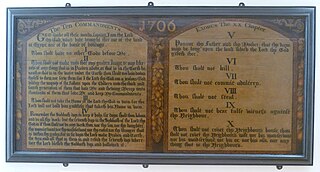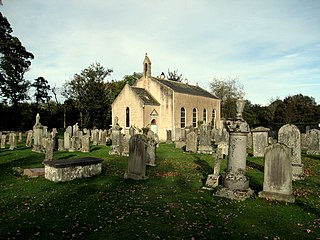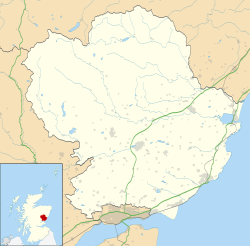
Kirk is a Scottish and former Northern English word meaning "church". It is often used specifically of the Church of Scotland. Many place names and personal names are also derived from it. Church of Scotland, national church in Scotland, which accepted the Presbyterian faith during the 16th-century Reformation.

The Kirk of the Canongate, or Canongate Kirk, serves the Parish of Canongate in Edinburgh's Old Town, in Scotland. It is a congregation of the Church of Scotland. The parish includes the Palace of Holyroodhouse and the Scottish Parliament. It is also the parish church of Edinburgh Castle, even though the castle is detached from the rest of the parish. The wedding of Zara Phillips, the Queen's granddaughter, and former England rugby captain Mike Tindall took place at the church on 30 July 2011. The late Queen Elizabeth II used to attend services in the church on some of her frequent visits to Edinburgh.

Airlie is a civil parish in the Scottish council area of Angus. It is the seat of the Earl of Airlie, and the location of Airlie Castle. It comprises Craigton of Airlie, Baitland of Airlie and Kirkton of Airlie. There is a standing stone in a field just east of the Baitland; various Pictish and Roman relics have been uncovered and the primary school is reputed to have been built on the site of an old graveyard. Airlie also contains one of the finest examples of a Pictish souterrain in Scotland, with the carving of a snake clearly visible in the ceiling.

Skene is a small farming community in North East Scotland some 10 km west of Aberdeen. The two traditional villages are Kirkton of Skene and Lyne of Skene. As the name suggests, Kirkton is still the location of Skene Parish Church. Lyne means 'glade' or 'enclosure'.

Skene Parish Church is a congregation of the Church of Scotland in Skene, part of the Presbytery of Gordon. The parish has two places of worship, Skene Church in Kirkton of Skene and Trinity Church in Westhill. The current minister is Rev. Stella Campbell.

Auchterhouse is a village, community, and civil parish in the Scottish council area of Angus, located 7.3 miles (11.7 km) north west of Dundee, 9.5 miles (15.3 km) south east of Alyth and 14.9 miles (24.0 km) south west of Forfar. It lies on the southern edge of the Sidlaw Hills, below Auchterhouse Hill, 1,398 feet (426 m) high. The parish, which is coterminous with the community, had a population of 520 in 2001. The village, formerly known as Milltown of Auchterhouse, straddles the B954 Muirhead to Newtyle road. About 1.0 mile (1.6 km) east lies the larger village of Kirkton of Auchterhouse, where the church and school are located.
Kirk is found as an element in many place names in Scotland, England, and North America. It is derived from kirk, meaning General Assembly ”Government” and "Church". In Scotland, it is sometimes an English translation from a Scots Gaelic form involving cille or eaglais, both words for 'church'. Rarely it is found in Anglicisations of Continental European placenames which originally had Dutch kerk or a related form.

Auchenblae is a village in the Kincardine and Mearns area of Aberdeenshire, formerly in Kincardineshire, Scotland. The village was known for its weavers, a whisky distillery and the annual Paldie's Fair horse market.

Kirkoswald is a village and parish in the Carrick district of Ayrshire, Scotland, 1+3⁄4 miles from the coast and four miles southwest of Maybole. It takes its name from its kirk (church), dedicated to Oswald of Northumbria, who is said to have won a battle here in the 7th century. The old church, which was built in 1244 and houses the baptismal font of Robert the Bruce, is now a ruin in the grounds of the modern church, which was built in 1777 to a design by Robert Adam. Kirkoswald is also noted for its connection with Robert Burns, whose maternal ancestors, the Brouns, were from the village. Burns also attended school here, and would later base the characters Tam o' Shanter, Kirkton Jean and souter Johnnie on village locals Douglas Graham, Jean Aird and John Davidson, the shoemaker.

Kirkton of Tough, usually shortened to Tough, is a settlement in the Marr area of Aberdeenshire, Scotland at grid reference NJ615129. It is about 4 kilometres southeast of Alford and 143 km (89 mi) from Edinburgh. Tough is where the Aberdeen Angus breed of cattle was first bred.

Kirkton of Durris is a hamlet in the Kincardine and Mearns area of Aberdeenshire, Scotland. Historic structures in the vicinity include Maryculter House, Durris House and Muchalls Castle.

Brindley & Foster was a pipe organ builder based in Sheffield who flourished between 1854 and 1939.

Cavers is a parish in the Scottish Borders area of Scotland, in the former county of Roxburghshire, south and east of Hawick. The largest village in the parish is Denholm.
Kirkton of Glenisla consists of a church and graveyard, a hotel, hall and several homes forming the largest concentration of habitation in Glenisla, Angus, Scotland. It is situated on the River Isla, eleven miles north-west of Kirriemuir and ten miles north of Blairgowrie, on the B951 road. The kirkton is situated adjacent to the 64 mile waymarked Cateran Trail. There is a suspension footbridge that was built in 1824 over the River Isla.

Cults is a small parish and hamlet close to the centre of the Kingdom of Fife, Scotland. It lies mainly in the Howe of Fife, and about 4+1⁄2 miles (7.2 km) south-west of the nearest town - Cupar. The parish is about 2+1⁄3 miles (3.8 km) long and 1+1⁄3 miles (2.1 km) wide.
Manor is a parish in Peeblesshire in the Scottish Borders, whose church lies on the west bank of Manor Water 3 miles south-west of Peebles.
James Kirkton (1628–1699) was a Church of Scotland minister and author.














